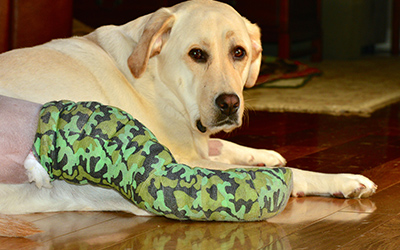Knee Surgery

Knee surgery can help treat most injuries or diseases in cats and dogs. Your pet may require a knee surgery if it has undergone structural damage of the knee during high-energy activities such as running or jumping. Dr. Pozzi is an expert veterinarian who offers minimally invasive arthroscopic and open surgery procedures for knee, including total knee replacement, knee reconstruction, knee meniscectomy, treatment of knee sepsis, and synovectomy of the knee.
Cranial Cruciate Ligament Rupture
If your pet goes lame in one of its hind legs, it may have ruptured or torn its cranial cruciate ligament (CCL). It is a strong band of tissue that connects the two main bones of the knee joint in your pet. Injury to the CCL may result in bones rubbing against each other, leading to arthritis, bone spurs, pain, and reduced range of motion. CCL injury can be treated both conservatively as well as surgically based on the seriousness of the injury sustained by your pet.
Meniscal Injury
The meniscus is a small, "C" shaped piece of cartilage in the knee. Each knee consists of two menisci, medial and lateral meniscus, that act as cushion between the thigh bone (femur) and shin bone (tibia) and disperse force and friction in the knee joint. Meniscal injury in pets occurs secondary to cranial cruciate ligament rupture leading to lameness in the hind legs. Surgery is the preferred treatment option as ruptured meniscus causes excruciating pain that does not improve with conservative treatment measures.
Patellar Luxation
Patellar luxation is a common condition in dogs, specifically small and miniature dog breeds. It is a condition in which the kneecap (patella) dislocates or moves out of its normal position. Typically, dogs with dislocated kneecaps display prolonged abnormal hind leg movements or lameness. Surgery is the preferred choice of treatment that can free your pet from lameness and dysfunction in most cases.
Septic Arthritis
Septic arthritis, also known as infectious arthritis, is characterised by inflammation of the knee joint due to contamination by environmental pathogens, usually bacteria, after the joint becomes exposed by a traumatic injury. Septic arthritis may affect dogs of any breeds and size and is commonly seen in male dogs between the ages of 4 and 7 years. Administration of antibiotics is the first line of treatment; however, for dogs with chronic joint infection, surgery is employed for removal of debris and to wash and clean the joint.
Osteoarthritis
Osteoarthritis, also called as degenerative joint disease (DJD), is the most common form of arthritis that can affect your pets. The disease occurs when the protective cartilage that cushions the ends of the bones wears out over time. Advanced age is one of the most common reasons for osteoarthritis followed by injury and obesity. Older dogs are highly prone to this disease. Medical treatment mainly aims at controlling the signs and symptoms, such as lameness, stiff gait, and decreased activity level in your dogs as there is no permanent cure to it. Surgery may help mitigate the symptoms and slow down the progression of the disease.
Osteotomy of the Femur and Tibia
Osteotomy of the femur and tibia is a surgical procedure in which the upper shinbone (tibia) and lower thighbone (femur) is cut and realigned. It is commonly indicated for pets with osteoarthritis that is isolated to only one side of the knee. During the surgery, Dr. Pozzi will remove or add a wedge of bone either below or above the knee joint depending on the site of arthritic damage. The aim is to take pressure off the damaged area and shift it to the other side of the knee with healthy cartilage.
Osteochondritis Dissecans
Osteochondritis dissecans is a joint condition in which a piece of cartilage, along with a thin layer of bone separates from the end of the bone because of inadequate blood supply. These fragments may be localised or may detach and fall into the joint space causing pain and joint instability. Osteochondritis dissecans most commonly affects the knee joint of dogs and cats. If the condition is diagnosed at an early stage and is mild, conservative treatment options are recommended. However, if the condition is diagnosed at an advanced stage or is severe, surgery is recommended.
Ligament Injuries
Your dog’s knee joint is comprised of 2 cruciate ligaments. These ligaments attach the thigh bone (femur) to the shin bone (tibia) and is responsible for stabilising the knee joint. The ligament can tear partially or completely causing significant pain, immobility, and lameness in the hind legs of your dogs. Trauma and degeneration of the ligament are the 2 main causes of ligament injuries in dogs. Medical management usually consists of physical therapy, rest, medication, and weight control for minor injuries. Surgery is mostly recommended to repair a torn cruciate ligament or serious injuries.
Revision Joint Surgery
Revision joint surgery in your pets is a surgical procedure employed for the failure of previous joint replacement surgery, in which all or part of a previously implanted artificial joint (prosthesis) is replaced with a new one. The goal of the surgery is to eliminate pain, improve mobility, and enable your pet to resume its normal activities. Some of the indications for revision joint surgery include worn out prosthesis, loosening of the prosthesis, fracture of the joint, infection in the prosthetic joint, and persistent pain and instability.




